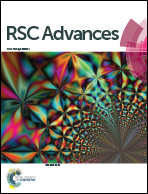Piezoelectricity and excellent temperature stability in nonferroelectric Bi12TiO20–CaTiO3 polar composite ceramics
Abstract
Nonferroelectric Bi12TiO20–CaTiO3 (BT–CT) composite ceramics were prepared through an interfacial reaction between presynthesized crystalline CaTiO3 and crystalline Bi12TiO20 phases at various sintering temperatures. After sintering at temperatures above the melting point of Bi12TiO20, both direct and converse piezoelectric effects were observed in these composites for the first time. Because neither CaTiO3 nor Bi12TiO20 is ferroelectric and because no obvious crystallographic orientation was found in these sintered composites, the temperature gradient-driven plastic flexoelectricity of the grain boundary amorphous phases might be the main poling mechanism. In this work, the highest d33 value of 8 pC N−1 was obtained in the samples sintered at 860 °C, which were found to contain a large amount of amorphous Bi12TiO20 and to possess the lowest density. For these BT–CT polar composite ceramics, the piezoelectric activity, the dielectric loss (tg δ ≈ 0.1%), the mechanical quality factor (Qm ≈ 2300), the depoling temperature (Td ≈ 880 °C) and the temperature stability of the resonance frequency are all comparable to those of the well-known bismuth layer-structured ferroelectrics, which indicates that these new polar composite ceramics are promising candidates for high-temperature piezoelectric applications.


 Please wait while we load your content...
Please wait while we load your content...